 Compact Luxury Crossover SUVs. Click image to enlarge |
2013 Acura RDX vs 2013 Audi Q5 vs 2013 BMW X3 vs 2013 Infiniti EX37 vs 2013 Mercedes-Benz GLK 350
Review and photos by Jonathan Yarkony, Michael Schlee, Peter Bleakney, Lesley Wimbush, Steven Bochenek and Jeff Wilson, title photo by Jeff Wilson
Photo Galleries:
Compact Luxury Crossover SUVs
2013 Acura RDX
2013 Audi Q5 2.0T
2013 BMW X3 xDrive28i
2013 Infiniti EX37
2013 Mercedes-Benz GLK 350
Introduction, by Jonathan Yarkony
The wagon is dead. Long live the crossover. Face it, wagon fans, crossover utility vehicles (CUV) – the trendy term now applied to ever-more-car-like SUVs – has essentially found the middle ground between stigmatized, slow-selling yet practical wagons and overweight, needlessly rugged but still practical SUVs. Manufacturers love them, marketers love them, and consumers love them. Crossovers are not the beastly 4×4 machines of yesteryear, but rather refined, all-season vehicles, flexibly practical, reasonably efficient while still fun and engaging, and appealing to the bourgeois masses. Not surprising then that luxury brands are flocking to them as the segment du jour.
Compact Luxury SUV sales grew at an explosive rate in 2012, up 25 percent from 2011 and breaking 30,000 units in sales (as per Desrosiers Automotive Consultants segment breakdowns). Granted, this volume pales in comparison with non-luxury Compact SUVs, which sell at nearly 10 times the rate (almost 280,000) with growth steady at almost 4 percent, but the luxury niche is ripe with profit margins for manufacturers.
Customers, too, can revel in a range of options like never before. Although slicing up the segment is tricky business, we selected a handful of compact luxury SUVs (and by now, the crossover or CUV designation is equally applicable for any of them) that have been recently refreshed or appear to present a competitive product.
The first-generation BMW X3 arrived on our shores as a 2004 model, but it took years for BMW to accept a reasonable ride compromise that meant a livable, comfortable suspension. This second generation was launched as a 2011, and for 2013 BMW customers can order it with the new 2.0L turbo-four that is making an appearance in just about every BMW product under two tonnes. With Premium, Tech, and more tech packages, our $42K X3 xDrive28i climbed its BMW pricing slope up to $52K with destination factored in.
The other veteran of the segment, the Acura RDX (around since 2007), is just now basking in the afterglow of its second-generation launch. It has followed the opposite course of the X3, trading in a frantic turbocharged I4 for a smooth V6 and a more mature personality. The RDX however, is of limited options, and our fully loaded 2013 Acura RDX Tech didn’t even break $46K, with freight charges applied, by far the most affordable in test (the X3 was the next cheapest), and clearly the value leader with many competitive features, even if lacking some amenities.
Over the past few years, we’ve seen an influx of new luxury cute utes from Infiniti, Audi and Mercedes-Benz, Volvo, and even a second from Land Rover, all eager to cash in on the crossover trend and to capture new customers to their premium brands. As much as we wanted the Volvo XC60 and slinky little Range Rover Evoque (or even the butch little LR2), they simply were not available, so we stuck with what the press fleet gods provided.
  2013 Luxury Compact SUV Comparison. Click image to enlarge |
The Infiniti EX37, with a fresh injection of muscle courtesy of its 3.7L V6 and looking every bit the alien kitten to the FX’s ‘bionic cheetah’ act, came in at $55,695 thanks to Premium, Navigation, Journey and Technology packages. The EX, it should be noted, is likely due for an all-new model and name (QX50) in short order, based on the upcoming Infiniti Q50 sedan replacing the G37.
Curiously, on test day we actually had a couple of Audi Q5s to choose from: the Q5 2.0T we had booked for the comparison, as well as a Q5 Hybridthat one of our contributors drove in with. The Q5 2.0T was mildly optioned with a nav system and paint upgrade for $53,595, and showed an unassuming, softly styled ‘SUV next door’ air.
At the very opposite end of the design spectrum from the EX and Q5 was the boxy Mercedes-Benz GLK, which one-upped everyone with 20-inch wheels straight out of the AMG catalogue. While those wheels are standard on the GLK 350, the Driving Assistance, Headlights, Navigation and Premium packages and some fancy paint brought the GLK up to $55,665, close behind the Infiniti’s highest price in test.
As 2013 promises to be another banner sales year if the economy stays on its tracks, and compact luxury crossovers will only grow even more popular. We weigh in on the notable options in this segment and determine which vehicle provides the best combination of stylish luxury, efficiency and value, and a balance of performance and practicality in this ‘nouveau wagon’ segment.
5th Place: 2013 Acura RDX, by Mike Schlee
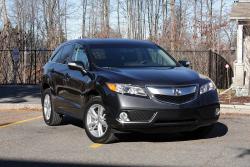 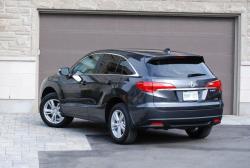 2013 Acura RDX. Click image to enlarge |
Four of the luxury crossovers showed up for this comparison test dressed in their best suit and tie; the X3, GLK, EX 37 and Q5 all featured their own brand of distinct, alluring styling that screamed “I am premium!” The Acura RDX, on the other hand, looked like it just woke up from an afternoon nap and still sported a white t-shirt and sweat pants. This isn’t to say the RDX is ugly, but it’s so much plainer, and lacks any flair or prestige in its design, that it could easily gets lost in the crowd with the likes of the Hyundai Santa Fe Sport, Ford Escape and Volkswagen Tiguan; not good for a premium brand. But being the plain Jane of the luxury compact crossover segment isn’t enough to be relegated to the back of the pack, there must be more; and sadly for the RDX, there is.
But before we get to that, let’s talk about the good. The RDX is the largest vehicle of this group in both length and height, and it accordingly felt very spacious and airy inside. It was rated best in test for rear seat comfort with three abreast as well as the king in cargo carrying abilities. The front seats were rated as some of the most comfortable in the test thanks to the soft, premium feeling leather, and the rest of the interior materials are of great quality; on par with most of the competitors and better than those found in the BMW X3.
The HVAC and infotainment controls are logically placed and easy enough to use, but they look about a generation behind in terms of design. This dated theme continues with all of the menu, infotainment and audio screens, with the exception of the navigation screen, which looks to be more like two generations behind.
But where the RDX really fell behind was on the road. In our eight ‘mechanical’ categories, which include things like drivetrain, easy to drive, fun to drive, ride comfort, handling, etc, the RDX finished last six times. The suspension was the weakest point as it offers a rough ride that clumps harshly over large bumps. The usual trade-off for a stiff ride is good handling, but here the RDX also finished at the back of the pack. The word ‘unrefined’ kept creeping up when comparing the general ride of the RDX to the other four crossovers in this test.
The 273-hp 3.5L V6 is powerful and responsive, providing more than enough thrust for this crossover. The gearbox, however, feels a bit outclassed here, not just due to the fact it gives up a gear or two to all of its competitors, but also in operation. It is potentially the least refined of the group and was as sluggish as the Infiniti’s seven-speed unit. It is also shocking that a Honda product can have steering this loose and disconnected; at times it does not feel like the wheel in your hands is connected to the front wheels.
    2013 Acura RDX. Click image to enlarge |
Having read this, you might think the RDX is a poor vehicle; it is not. In this company it is just overmatched. However, with an as-tested price undercutting the rest of the competition here by $6,000 to $10,000, the RDX is a great deal. This raises the question of whether or not this deal is good enough to overcome the RDX’s shortcomings in looks, content and refinement. In our opinion the answer is no. But potential shoppers in this segment should ponder it, especially those who value, well, value and practicality over any dynamic facets.
Pricing: 2013 Acura RDX Tech
Base price (Tech): $43,990
Options: None
Freight: $1,945
A/C Tax: $100
Price as tested: $46,035
Observed fuel consumption: 12.6 L/100 km
4th Place: 2013 Infiniti EX37, by Lesley Wimbush
|
2013 Infiniti EX37. Click image to enlarge |
Here we have another odd little vehicle that’s difficult to categorize. Is it a wagon? SUV? A tall hatchback that handles like a RWD sports sedan? Okay then, crossover it is.
In contrast to the rest of our comparison entries, the EX37 is composed of voluptuous curves, where the others are straight lines, simple rounded boxes, and sharp angles. The roofline is generously curved, but ends sharply in a truncated rump. It makes a strong design statement; whether it’s a good one is entirely subjective.
The interior is busy, but obviously very finely crafted. Leather surfaces look, feel and smell sumptuous. Seats ranked the highest overall, with bolstering right where you need it. The centre stack is a showpiece trimmed in real wood – beautifully finished with none of that cheesy faux-wood gloss. Highest ranked in ergonomic friendliness, the EX37’s instrumentation features a tiny analog clock that’s an exquisite timepiece.
The sound system flat-out rocked – it was easily the best of the bunch with deep bass that resonated without buzzing, and crystalline high notes.
Drivers will embrace the stitched leather steering wheel that’s notched and grippy and just feels great in the hands. It’s connected to speed-sensitive steering that has decent feedback, and while light enough for parking lot maneuovers, is nicely weighted at highway speeds.
Performance, too, was tops. The EX37 is powered by a wonderfully smooth 3.7L V6 producing 325 hp and 267 lb-ft of torque. It responds instantly to the throttle, lively yet refined and quiet. It’s mated to a seven-speed transmission boasting crisp downshifts and never seems to be in the wrong gear.
The EX37 shares most of its underpinnings with the G37 sedan, which explains why this curvy crossover drives like a sports sedan. Double front wishbones and a multi-link rear setup keep the EX37 flat and composed where others in the segment showed some body roll – yet the ride isn’t at all punishing. Its surefooted agility is augmented by a seamless all-wheel-drive system that, while rear-wheel biased, is able to send up to 50 percent of the torque to the front wheels if needed.
So, with all this glowing acknowledgement of the EX37’s attributes, why did we rank it second to last?
In terms of practicality, the fun-to-drive EX37 falls far short in our ranking.
|
2013 Infiniti EX37. Click image to enlarge |
The dramatically swoopy roofline and small rump result in a greatly reduced cargo area, and the lowest of the group. And for $55,695 ($13,800 in options alone!) it’s almost offensive not to include a power liftgate.
Rear seating can best be described as ‘cramped’; it’s not bad for two people, but there’s not much headroom. Add a third, and the unlucky soul in the middle has to straddle the transmission hump, and have his/her knees jammed up against the back of the centre console.
That lovely powertrain proved the thirstiest of the bunch too, with 13.3 L/100 km average fuel consumption on comparison day compared to the Audi Q5, which, at 11.9, was the lowest.
The EX37 is delightful to drive – and for some people, that’s more than enough. But it probably won’t delight those for flexibility and practicality as well.
Pricing: 2013 Infiniti EX37
Base price: $39,900
Options: Premium Package – $4,150; Journey Package – $3,900; Navigation – $2,950; Technology Package – $2,500; 3-Coat paint – $300
Freight: $1,995
A/C Tax: $100
Price as tested: $55,795
Observed fuel consumption: 12.6 L/100 km
3rd Place: 2013 BMW X3 xDrive28i, by Steven Bochenek
|
2013 BMW X3 xDrive28i. Click image to enlarge |
Placing third for the BMW X3 is appropriate not just because of this crossover’s name. Of 31 categories judged, the only two the X3 xDrive28i won were Warranty and Ease of Front Entry (which was a three-way tie). Does it get any more SUV middle-of-the-road than that?
And maybe the middle’s where you want to be. After all, crossovers are by definition a compromise, the modern design equivalents of ‘80s malls. How? They’re designed to be enjoyed primarily from the inside, and outward looks become an afterthought, if thought of at all. (When’s the last time you heard the phrase “as pretty as a plaza” or as “graceful as a ute”?)
The point? There’s a sameness of look that transmogrifies the utility in SUV to utilitarian. But for that signature BMW grille, the X3 tends to this sameness. Try this simple test. Tomorrow, well after you’ve read this article, return and quickly look at the introductory photo. Which vehicles leap out first? Not the X3, and that explains why it was fourth in Exterior Styling. It placed last for Exterior Accents like wheels and lights. Even those elongated headlight casings, a unique X-Line design feature, weren’t enough to impress.
Inside, at first, the comparison story doesn’t change much. It also placed last for Interior Styling and the Quality of Materials. The door handles lacked refinement. And the ubiquitous beige of this tester earned the scorn of co-reviewers for its blandness.
A recovering child of the ‘70s, I’m no champion of beige – nor of the X3’s leatherette, whose very name evokes visions of family dinners at Denny’s – but in winter, which this was, the brighter colour lightened the interior and soaked up the daylight streaming through the panorama sunroof. Mind, it also highlighted the panel gaps and mismatched colours between the various upholsteries and plastics.
(That sunroof is part of the $3,600 Premium Package that includes the aforementioned X-Line, auto-dimming mirrors, park distance control, and bi-xenon headlights.)
Driving, however, the X3’s story did improve somewhat. The steering was a bit light but laser accurate.
When someone says four cylinders, you may not get excited but when they preface that with BMW TwinPower turbo, it gets your attention. It unleashes a peppy 240 ponies and 250 lb-ft of torque from 1,250 to 4,800 rpm. Hello! Suddenly we’re a beige catapult.
|
2013 BMW X3 xDrive28i. Click image to enlarge |
The X3 was responsive in Sport and Comfort modes, inertia-defiant in corners, and a thrilling few minutes’ drive. Its problem was that several other testers were, too. So it placed in the middle of a highly competitive group.
How competitive? Consider Braking Feel: placing last, it was just 0.34 points behind first — like Canadian racers in the Olympics. In Emotional Appeal it was close to first too, though scoring fourth.
It also placed last for Ease of Parking, but all the others had rear-view cameras. On this clear day, free of slush or mud, BMW’s radar icon graph, courtesy of the Premium Package, couldn’t compete.
While it’s a satisfying drive and appropriately placed ahead of the Infiniti EX and Acura RDX, the X3 simply couldn’t stand out against its fellow German competitors.
Pricing: 2013 BMW X3 xDrive28i
Base price (xDrive28i): $42,450
Options: Premium Package – $3,600; Technology Package – $2,200; BMW Apps Package – $300; Cargo pass-through – $200; Sirius satellite radio tuner – $450; Metallic paint – $800
Freight: $2,095
A/C Tax: $100
Price as tested: $52,195
Observed fuel consumption: 12.3 L/100 km
2nd Place: 2013 Mercedes-Benz GLK 350, by Jeff Wilson
|
2013 Mercedes-Benz GLK 350. Click image to enlarge |
The rest of the compact luxury SUVs in this test seem to have styling inspired by garden vegetables and dinner rolls. An Infiniti Turnip here; an Audi Crusty Bun there. Not so the GLK 350, which is clearly a mechanical beast, rugged and macho with its purposeful stance and hard edges.
It’s no surprise then that our GLK 350 tester was the runaway favourite for exterior styling in this group. Although updated for 2013, the GLK is still immediately recognizable as not only the son of Gelandewagen with its military-precise creases, but assuredly a Mercedes-Benz thanks to its dinner plate–sized three-pointed star on the grille. This latter point is of immeasurable importance when showing off for the neighbours or tossing the keys to the valet at your favourite fancy restaurant.
Inside the little Benz is a looker too. A broad swath of gorgeous dark stained ash spans the dashboard and contrasts brilliantly with the circular metallic vents reminiscent of a sniper’s reticle. While the Infiniti and Acura’s interior may offer a more modern-looking and high-tech cockpit, there is simplicity and classic, unmistakable Benz-ness here. The shape and support of the seats ensure they will be comfortable for a broad spectrum of driver shapes and sizes, and like the rest of the interior materials, simply feel as if they’ve been hewn from solid stuff.
It takes more than sexy styling to woo this crowd, though, and the Benz delivers on performance, too. Winning the drivetrain category against some very impressive competition, the venerable 302-hp V6 is smooth and strong, and makes a sophisticated soundtrack without being loud. Plus, with the Eco start/stop function, the GLK achieved an average consumption rate of 12.8 L/100 km – just barely behind the smaller and much less powerful BMW turbocharged four-cylinder.
The seven-speed automatic transmission shifts cleanly and is well matched for the engine, keeping revs (and consumption) down when possible, but quick to call up the power when needed.
Despite a new Agility Control suspension designed to deliver a more supple ride than the previous generation GLK, this ute still produces what I found to be the firmest ride (though consensus pegs the RDX as least comfortable), also largely attributed to the handsome, but impractically large 20-inch wheels. This firmness, coupled with a granite-like platform rigidity, produces a planted feel on the road and makes for an overall sense of quality and solidity. Though it’s unlikely many GLKs will ever venture further off-road than the gravel cottage laneway, it feels as if it could take a serious pounding without complaint, delicate wheels notwithstanding.
|
2013 Mercedes-Benz GLK 350. Click image to enlarge |
The GLK 350 is a strong performer across the board, either winning or placing mid-pack in every crucial area. Its distinctive squared-off shape serves passengers well for both ingress and egress and provides great sightlines for parking without the dependency on rearview cameras as with some of the GLK’s competitors.
Once nestled inside, a pair of rear passengers are as likely to find comfort in the little Benz as in the Audi or larger Acura (and notably better than in the Infiniti). With three side-by-side, none of these SUVs will provide Escalade-sized spaciousness, but the GLK ranked average in this group, as it did in cargo space.
The GLK 350 wins one more blue ribbon in this group, claiming the most votes for ‘emotional appeal’. With its good looks, tremendous powertrain and, of course, that legendary Mercedes-Benz brand cachet, is it any wonder?
Pricing: 2013 Mercedes-Benz GLK 350 4Matic
Base price (GLK 350 4Matic): $44,900
Options: Driving Assistance Package – $800; Bi-Xenon Headlamps Package – $1,000; COMAND Navigation Package – $2,400; Premium Package – $3,600; Diamond Silver Paint – $890
Freight: $2,075
A/C Tax: $100
Price as tested: $55,765
Observed fuel consumption: 12.8 L/100 km
1st Place: 2013 Audi Q5 2.0T, by Peter Bleakney
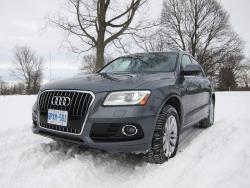 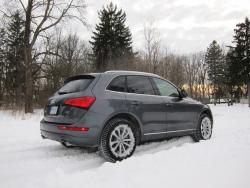 2013 Audi Q5 2.0T. Click image to enlarge |
The Audi Q5 is the master of understatement. It’s not exactly a wild party to look at, calling the interior understated might well be an overstatement, and the Q5’s advertised 211-horse count makes for the sparsest stable in this showdown.
Yet when the dust settled, the Audi squeaked a victory over the fetching and capable Mercedes-Benz GLK 350. And that’s because the Q5 is a commendably cohesive piece that is thoroughly enjoyable to drive, and it shows an obsessive attention to detail that will warm the hearts of anyone who appreciates fine design and workmanship.
And we still think that 211 hp rating from the 2.0L direct-injection turbo-four might be a bit modest, although it really is the 258 lb-ft available from 1,500 rpm that does most of the talking. This engine and the smooth eight-speed auto make for a good pair, and proved the most fuel efficient here by a slight margin.
The Q5’s rear seats got the highest marks for space and comfort, and the front chairs were excellent, too, but ultimately outscored by the EX37’s snug seats and the Acura’s cushy ones.
On the road, the Q5 is a competent handler and it got the best marks for Ride Comfort and NVH as well as taking the Easy to Drive category. We scored it second in handling to the rip-snortin’ Infiniti, which is essentially a G37x sedan with a thyroid problem. While the tippy BMW X3 felt like an SUV, this Audi was very car-like in the way it carried itself. It was also the favourite for steering feel, although this tester would have appreciated a bit more meaningful heft to the helm.
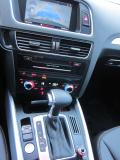 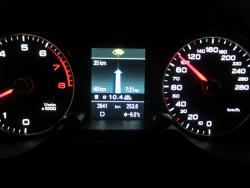 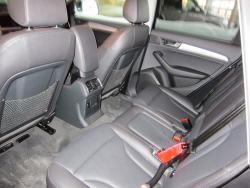 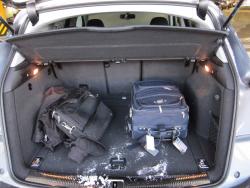 2013 Audi Q5 2.0T. Click image to enlarge |
Where the Q5 lagged was in cargo space behind the rear seats and ease of parking, the latter due to thick D pillars and curving flanks that were hard to gauge, especially compared to the Infiniti’s around-view cameras and the GLK’s upright shape and large windows.
Indeed, the Q5 is not particularly exciting, and when compared to the GLK’s chunky look-at-me exterior (on those 20-inch AMG wheels no less) and its bold interior, the Q5 comes across as quite a wallflower.
Sometimes still waters run deep. You know the Q5’s classic and ergonomically sound interior will never grow tiresome, nor will the driving experience that blends all-day comfort with just enough sport.
Pricing: 2013 Audi Q5 2.0T
Base price (2.0T): $47,650
Options: Navigation with Park Assist – $3,200; Monsoon Grey Metallic – $750
Freight: $1,995
A/C Tax: $100
Price as tested: $53,695
Observed fuel consumption: 11.9 L/100 km














